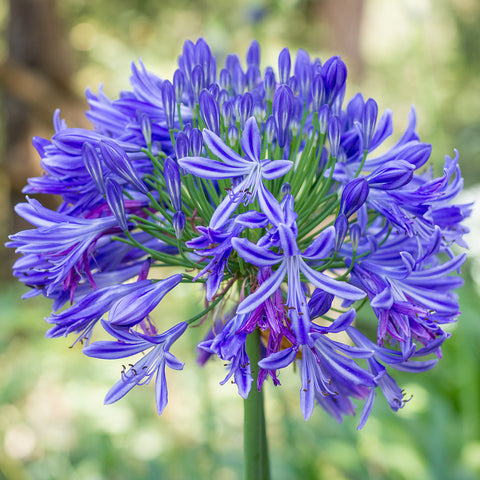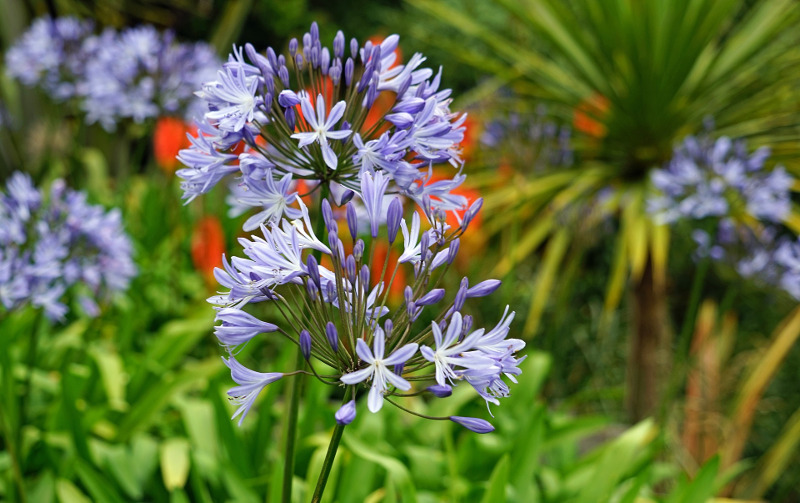Typical Agapanthus Issues and How to Address Them
Typical Agapanthus Issues and How to Address Them
Blog Article
Understanding the Art of Agapanthus Treatment: Important Steps for Healthy Growth and Dynamic Blooms
In the world of gardening, the farming of agapanthus stands as a gratifying undertaking for those that seek to nurture these elegant flowering plants. From selecting the appropriate variety to mastering pruning strategies, the journey in the direction of growing flourishing agapanthus plants is complex and holds the essential to unlocking the full possibility of these herb treasures.

Picking the Right Agapanthus Variety

When selecting the ideal Agapanthus range for your yard, take into consideration elements such as environment viability, blossom color, and growth practice. Agapanthus, generally called Lily of the Nile or African lily, is available in a range of shades varying from shades of purple and blue to white. Choose a bloom color that enhances your existing yard scheme to create a harmonious landscape. Additionally, take into consideration the environment in your region to guarantee the Agapanthus variety you pick can thrive in your details problems. Some ranges are a lot more tolerant of cool temperatures, while others choose warmer climates. Comprehending the growth behavior of different Agapanthus selections is crucial for proper positioning within your yard. Some ranges have a clumping growth routine, perfect for borders or containers, while others have a more spreading nature, ideal for ground cover or mass plantings. By thoroughly evaluating these factors, you can pick the best Agapanthus selection to improve the beauty of your yard.
Suitable Planting Problems
Taking into consideration the optimal environmental demands is important for effective Agapanthus farming. Agapanthus thrives in well-draining soil with a slightly acidic to neutral pH level. When planting, pick an area that receives complete sunshine to partial shade. In hotter environments, supplying some mid-day shade can stop scorching of the leaves. Agapanthus plants are sensitive to chilly temperatures and should be secured from frost during wintertime months.
To ensure healthy growth and vibrant blossoms, plant Agapanthus bulbs at a depth of concerning 2-4 inches and area them 8-12 inches apart. Mulching around the base of the plants aids keep wetness and suppresses weed growth.
Watering and Fertilizing Tips
Preserving proper moisture degrees and offering essential nutrients are key aspects in the treatment program for Agapanthus plants. When it comes to watering Agapanthus, it is crucial to strike an equilibrium. These plants choose consistently wet dirt but are susceptible to root rot if overwatered.
Fertilizing Agapanthus is crucial for promoting healthy and balanced growth and prolific flowers. Apply a well balanced plant food, such as a 10-10-10 formula, in the very early springtime as brand-new growth emerges. By following these watering and fertilizing ideas, you can ensure your Agapanthus plants grow and produce vibrant, resilient blooms.
Pruning Techniques for Agapanthus
Pruning Agapanthus plants at the proper times and with appropriate methods is important for maintaining their health and wellness and advertising optimum growth and blooming. The suitable time to trim Agapanthus remains in late winter season or early springtime before brand-new development emerges. Beginning by eliminating any kind of dead or yellowing fallen leaves near the base of the plant. Cut them as close to the ground as possible without harming the arising shoots.
Deadheading spent flowers can also redirect the plant's energy into creating even more flowers rather than setting seeds. If you desire to gather seeds for proliferation, leave some flowers to completely dry and mature on the plant.
Bear in mind to make use of tidy, sharp tools to make precise cuts and lower the danger of introducing illness. Agapanthus. Routine trimming will see it here certainly help keep your Agapanthus looking cool and healthy and balanced while guaranteeing a bountiful display screen of gorgeous flowers
Managing Usual Bugs and Illness
After ensuring proper pruning strategies for Agapanthus, it is necessary to attend to typical pests and diseases that can impact the wellness and vitality of these plants. Agapanthus plants are typically durable however can still come down with certain problems. One common bug that affects Agapanthus is the Agapanthus gall midget. This small, orange fly lays its eggs in the foliage, causing distorted development and blossom buds that stop working to open up. To fight this insect, trim and damage any afflicted plant site components and think about using insecticidal soap.
One more usual problem is fungal leaf place, which presents as dark lesions on the fallen leaves. To avoid fungal diseases, make certain good air circulation around the plants, avoid above watering, and remove any contaminated leaves immediately. Furthermore, Agapanthus plants can deal with origin rot if they are grown in badly draining soil. To stop this, plant Agapanthus in well-draining soil and prevent overwatering. By being attentive and taking prompt activity versus bugs and diseases, you can aid your Agapanthus plants thrive and produce dynamic flowers.

Final Thought
Finally, grasping the art of agapanthus care involves picking the right variety, giving excellent growing conditions, correct watering and feeding, appropriate trimming methods, and dealing with common bugs and conditions. By complying with these vital steps, you can make sure healthy development and lively blossoms for your agapanthus plants. Remember to on a regular basis check and preserve your plants to advertise their total health and longevity.
To ensure healthy and balanced development and vibrant blooms, plant Agapanthus bulbs at a depth of regarding 2-4 inches and room them 8-12 inches apart. By following these watering and fertilizing pointers, you can guarantee your Agapanthus plants flourish and produce lively, long-lasting find this flowers.
One common insect that affects Agapanthus is the Agapanthus gall midge. In addition, Agapanthus plants can experience from root rot if they are planted in inadequately draining dirt. By complying with these necessary actions, you can guarantee healthy and balanced development and vibrant blossoms for your agapanthus plants.
Report this page